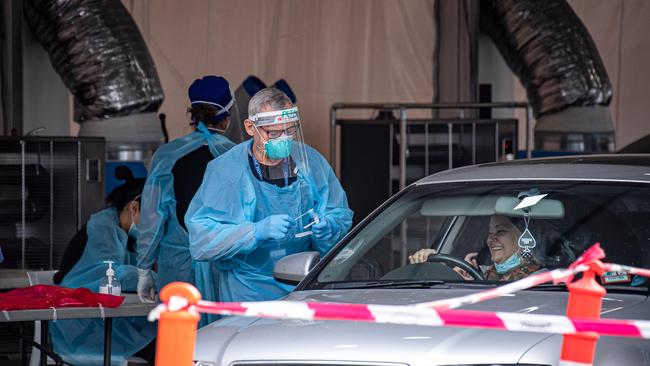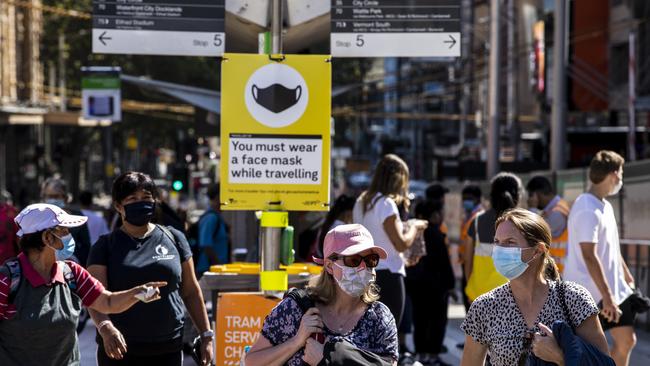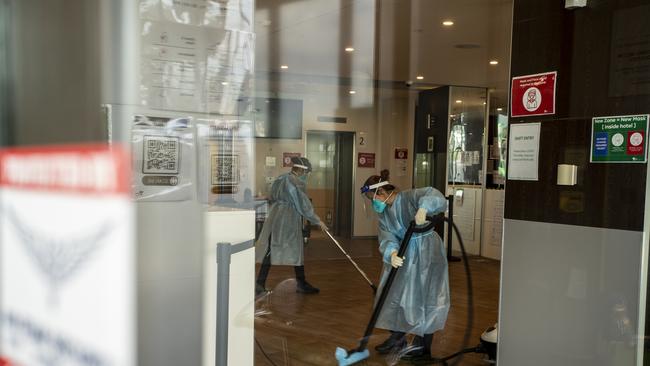UK strain created perfect storm for virus to run wild and clamp Victoria back into lockdown
It was a perfect storm that saw the mutant UK virus variant escape hotel quarantine and plunge the state back into lockdown. Here’s how it unfolded.

News
Don't miss out on the headlines from News. Followed categories will be added to My News.
A perfect storm saw the supercharged UK coronavirus variant escape Victoria’s hotel quarantine program with such speed contact tracers can no longer hope to catch it.
Able to spread up to 80 per cent faster than strains of SARS-CoV-2 virus which ravaged Melbourne last year, the Holiday Inn COVID-19 outbreak was on Friday revealed to be infecting new cases faster than health authorities could return positive coronavirus tests and phone close contacts.
Victoria’s Chief Health Officer Brett Sutton said the complications of the more infectious UK variant being spread to several people at the same time through the use of a nebuliser was making it impossible for contact tracers to keep pace, even with the new three-ring contact approach that shut down the Black Rock cluster in December.
“We have essentially had a super spreading event at the hotel with multiple residents and staff all being infected in the first instance,” Prof Sutton said.

“It is significantly more infections than any other virus we have seen previously, and we are seeing this play out in the cases we have had in this cluster of cases in Victoria.
“There are individuals who are becoming symptomatic and testing positive who’ve already infected their close contacts.”
While all of the Holiday Inn outbreak’s 13 cases have so far been guests, workers or their close contacts already in isolation, revelations that one case had worked at Brunetti cafe Melbourne Airport On February 9 have heightened fears it may have already jumped containment lines, as it did in Europe.
First identified on September 20 last year, the variant labelled as B117 had probably mutated a fortnight earlier.
Doherty Institute genomic epidemiologist Dr Sebastian Duchene said alarms bells immediately rang around the world when the extent of its mutations were realised.
Changes to the spike patients on the outside of the virus allow it to bind much even more effectively with human tissue than previous versions of the coronavirus, though its exact mechanism remains unclear.
By early December 2020 the B117 variant had already become the most dominant strain in the UK.
“This one very clearly spreads up to 80 per cent faster than the other five most common lineages in the UK,” Dr Duchene said.
“It has all these mutations that we have seen for ages everywhere – but all combined in a single variant. That was unheard of.
“The rate at which it was going was much, much fast than everything else.
“It was out competing the other variants. It was growing at a time when everything else was stable, and that is what was really worrying.”
Beside the increased transmissibility of the UK variant, Walter and Eliza Hall Institute infectious disease expert Professor Marc Pellegrini said there were a number of factors which led to mini outbreaks outrunning European authorities.
In December two UK travellers in quarantine became Australia’s first COVID-19 cases confirmed with the UK variant.

On January 7, a cleaner at a Brisbane quarantine hotel was found to have been infected with B11, followed on January 30 by a quarantine guard in Perth. The UK strain was this month transmitted between guests in different room at Melbourne’s Park Royal Hotel quarantine hotel and then a worker at the Grand Hyatt – but each occasion conventional contact tracing methods and luck saw for the virus’ race out of quarantine false start.
However, an oversight that saw a nebuliser used in the room of an infectious Holiday Inn guest on February 3 and 4 gave the virus the head start it needed to ensure authorities would not catch up, Prof Pellegrini said.
“The virus can certainly put running shoes on – obviously the UK variant has better running shoes compared to some of the original strains,” Prof Pellegrini said.
“If the virus has got running shoes and you were actually providing with a good headwind, the combination of the two spells for it winning the race quite convincingly – and that race is to infect people.
“It could have easily been the South African strain, it could have been something else, but I imagine it would have been the same.”

The B117 variant is now responsible for 75 per cent of COVID-19 cases in Australian quarantine and, although it’s mere transmissibility may not a sole factor in whether or not it escapes quarantine, he said it would become a major issue if it breached containment measures placed around the program.
“Here we have a naive population, not many restrictions at the moment, so it could spread much faster than what we saw in the second wave,” Dr Duchen said.
“Once it is the community the risk of it spreading and the speed at which it will spread is faster.”
Although he expects Holiday Inn outbreak cases to increase among those already in isolation, Prof Pellegrini said he had confidence at this stage the “small leak” will not hit the wider community.
But he is not as assured the speed of the UK strain can be managed if international arrivals increase and the leaks become larger.
“The big thing will happen when we start contemplating opening up the borders a little bit more freely and suddenly we will get a barrage of not just one virus with its running shoes on, but hundreds of viruses with running shoes on or trying to escape quarantine,” he said.
WHAT IS THE UK CORONAVIRUS STRAIN?
The UK strain, also known as the B117 variant, was first discovered in Kent, southeast England in September last year.
It was thought to have started in a patient with weakened immunity. As they struggled to fight off the virus, this was the perfect condition for it to mutate and incubate before being passed on. This variant has now been found in more than 50 countries.
It is the predominant strain in England, UK and is fast becoming the main virus globally.
The Victorian Premier described this variant yesterday as the “fastest moving, most infectious strain of coronavirus we have ever seen”.
It is known to be “super infectious” because it can spread twice as fast.
This strain has 23 genetic mutations and has evolved its structure physically so it can more easily attach to human cells.
This means infected people are passing it on to close contacts quicker.




